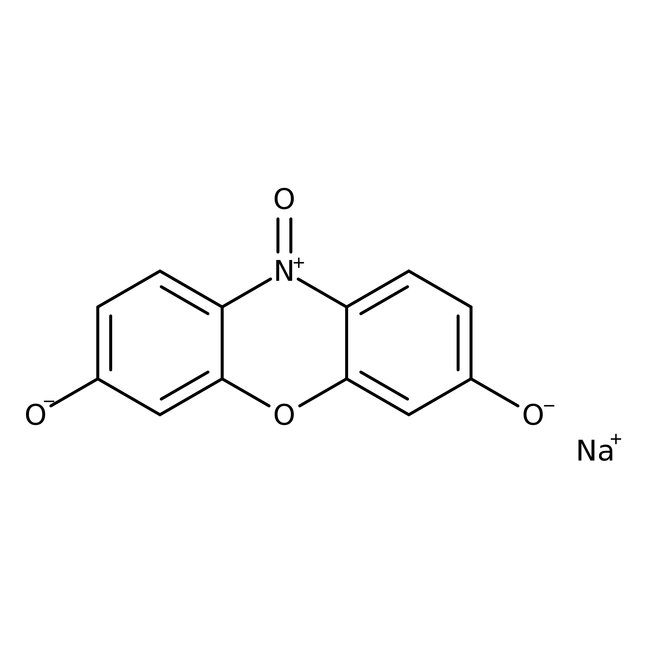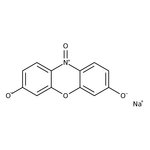Search Thermo Fisher Scientific
Thermo Scientific Chemicals
Resazurin sodium salt
As indicator pH 3.8 (orange) to 6.5 (dark violet)
Catalog number ALFB21187.06
Price (MYR)
755.00
Quantity:
5 g
Price (MYR)
755.00
Specifications
Chemical Name or MaterialResazurin
CAS62758-13-8
Health Hazard 1H315-H319-H335
Health Hazard 3P261-P264b-P271-P280-P302+P352-P304+P340-P305+P351+P338-P312-P332+P313-P362-P501c
Recommended StorageAmbient temperatures
View more
As indicator pH 3.8 (orange) to 6.5 (dark violet)Resazurin sodium salt acts as a blue non-fluorescent dye used especially in oxidation-reduction indicator of resazurin test for bacteria. It is employed as a fluorogenic oxidation-reduction indicator in a variety of cells, yeast and eukaryotes by flow cytometry, fluorescence microscopy and high-throughput screening. Further, it is used to characterize the metabolic activity of mitochnodria. It is also used to assay L-Glutamate and to measure the aerobic biodegradation of organic matter exists in effluents. In addition to this, it acts as an indicator for cell viability in mammalian cell cultures.
This Thermo Scientific Chemicals brand product was originally part of the Alfa Aesar product portfolio. Some documentation and label information may refer to the legacy brand. The original Alfa Aesar product / item code or SKU reference has not changed as a part of the brand transition to Thermo Scientific Chemicals.
Applications
As indicator pH 3.8 (orange) to 6.5 (dark violet)Resazurin sodium salt acts as a blue non-fluorescent dye used especially in oxidation-reduction indicator of resazurin test for bacteria. It is employed as a fluorogenic oxidation-reduction indicator in a variety of cells, yeast and eukaryotes by flow cytometry, fluorescence microscopy and high-throughput screening. Further, it is used to characterize the metabolic activity of mitochnodria. It is also used to assay L-Glutamate and to measure the aerobic biodegradation of organic matter exists in effluents. In addition to this, it acts as an indicator for cell viability in mammalian cell cultures.
Solubility
Soluble in water, dimethylsulfoxide and ammonium hydroxide.
Notes
Incompatible with strong oxidizing agents. Store in a cool place.
As indicator pH 3.8 (orange) to 6.5 (dark violet)Resazurin sodium salt acts as a blue non-fluorescent dye used especially in oxidation-reduction indicator of resazurin test for bacteria. It is employed as a fluorogenic oxidation-reduction indicator in a variety of cells, yeast and eukaryotes by flow cytometry, fluorescence microscopy and high-throughput screening. Further, it is used to characterize the metabolic activity of mitochnodria. It is also used to assay L-Glutamate and to measure the aerobic biodegradation of organic matter exists in effluents. In addition to this, it acts as an indicator for cell viability in mammalian cell cultures.
Solubility
Soluble in water, dimethylsulfoxide and ammonium hydroxide.
Notes
Incompatible with strong oxidizing agents. Store in a cool place.
RUO – Research Use Only
General References:
- Yang, G.; Zhu, W.; Kim, K.; Byun, S. Y.; Choi, G.; Wang, K.; Cha, J. S.; Cho, H. S.; Oldfield, E.; No, J. H. In Vitro and In Vivo Investigation of the Inhibition of Trypanosoma brucei Cell Growth by Lipophilic Bisphosphonates. Antimicrob. Agents Chemother. 2015, 59 (12), 7530-7539.
- Mealy, J.; O'Kelly, K. Cell response to hydroxyapatite surface topography modulated by sintering temperature. J. Biomed. Mater. Res. A 2015, 103 (11), 3533-3538.



